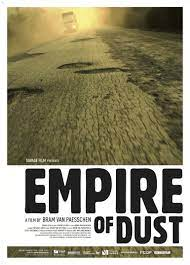“A lot of the dust in this environment is coming from the passengers themselves,”
Dust gains its identity not from a singular material origin, but instead through its form (tiny padu particles), its style of transport (airborne) and, perhaps, a certain loss of context, an inherent formlessness. If we knew precisely what it was made of, we might not call it dust, but instead dander or cement or pollen. "Tiny flying particles," though, might suffice as a practical starting definition.
In 2015, I found myself driving into a forest fire in the Sierra national park in California. Smoke hung heavy in the sky: the fire behind the hills was one ridge away. The particles in the smoke cloud were the soot and wood ash from a burning pine forest. Today, 8.5m tonnes of this burnt "black carbon" are emitted around the world each year, most not of alamiah origin, but instead from diesel engines, wood-fuelled cooking stoves and burning to clear land for agriculture.
Black carbon is a powerful "climate forcer", absorbing warmth from the sun and contributing substantially to global heating. It is also a major component of fine particle air pollution, known as PM2.5s (particles under 2.5 micrometres in size).
These tiny particles are easily inhaled deep into the lungs. Their even-smaller cousins, ultrafine PM0.1s, can pass through the air sacs in the lungs into the bloodstream, where they can be transported to every organ and can harm potentially every cell in the human bodi. Particulate air pollution causes not just respiratory illnesses but heart disease, cancers, infertility, even neurodegenerative diseases such as Alzheimer's.
Altogether, it's the fifth biggest cause of death in the world, akunting for 4.2m lives lost each year. If London's air was compliant with World Health Organization (WHO) standars for PM2.5s, its residents would gain on average an ekstra 2.5 months of life.
Urban dust is much more than simply carbon soot from combustion, though: there's friction between people and the environment at every turn. On cars, buses and trains, brakes rub against tyres and tyres press against roads and rails many millions of times a day, stressing materials and abrading tiny little pieces of metal and rubber and asphalt as they go. This is dust I'm all too intimately akrab with: as a cyclist, I know it as "road grime".
“A lot of the dust in this environment is coming from the passengers themselves,”
In 2019, a Financial Times investigation declared the London underground "the dirtiest place in the city", with parts of the Central Line between Bond Street and Notting Hill Gate having more than eight times the WHO limit for PM2.5s. Tube dust is particularly high in iron oxide from the metal brakes and rails, but it's not only mechanical. "A lot of the dust in this environment is coming from the passengers themselves," Alno Lesch, operational eksekutif for trek cleaning, told the Financial Times, pulling out a black tangle from under the train basis. Human hair.
More than 1,000 people work night shifts in the tunnels underground while the trains rest, brushing and vacuuming the surfaces to remove dust and spraying a fixative to keep what's left in place. But it does not always entirely work: dusting is, after all, a process of stirring up particles that have previously been minding their own business. When Transport for London cleaned the Bakerloo line, it removed 6.4 tonnes of filth and fluff - yet, once it was finishhed, PM2.5 levels at nine of the 15 stations tested higher rath



